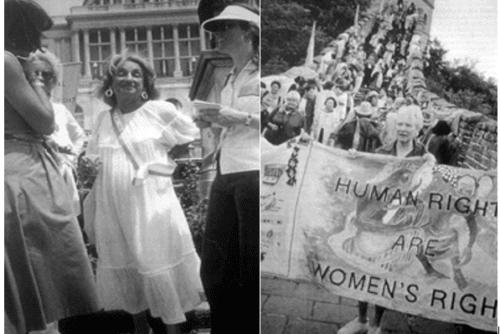The contemporary production of an “immigration” crisis is only the most recent moment in a much longer U.S. history of peaks in anti-immigrant sentiment during periods of national insecurity: whether Chinese, Irish, Jewish, Mexican, or Russian, or even freed slaves migrating to Northern cities after the Civil War. In the last decade, Immigration and Nationality Service (INS) inspectors at checkpoints along the U.S.-Mexico border have reported increases in human trafficking and smuggling; they find people rolled inside carpets, sewn into car seats, and stuffed into washing machines. At the Tecate Port of Entry, a 5-year old girl was discovered, meticulously sealed inside a piñata. 1 Border enforcement projects, like Operation Gatekeeper, have added expensive fencing and militarized the urban border areas. Meanwhile, the Border Patrol has unearthed dozens of elaborate underground tunnels straddling the border through which migrants and goods are smuggled. Yet while the increased militarization of the border has made “illegal” crossing more difficult and treacherous, it has not reduced the numbers of people putting themselves at risk to work in the U.S. Border officials suggest that the militarization of the border has made it dangerous and even fatal for male migrants to cross back and forth, and has forced these men to work undocumented in the U.S. Women and children remain in Mexico, or pay expensive “coyotes” to smuggle them across. Yet this production of a contemporary “immigration crisis” absents the historically unequal relationship between the U.S. and Mexico, which reaches back to the conquest and war in the 19th-century, continued in the subordination and exploitation of Mexican residents in the U.S. as noncitizen workers, and is exacerbated by neoliberal globalization today. 2 The Mexican debt crisis of 1982, and Mexico’s entry into the General Agreement on Tariff and Trade (GATT) and the North American Free Trade Agreement (NAFTA), decisively opened the country to global economic restructuring and reconfigured many border areas as export processing zones for multinational corporations. Peso devaluation and neoliberal reforms have resulted in even more dramatic cuts in Mexican state provisions for education and health care, sending greater numbers of people into poverty. All of the human traffic at the border takes place in the context of these longstanding global inequalities.
In other words, even as global conditions disaggregate state sovereignty, the state still continues to flex its muscles to exert a role in border and immigration policies, though its power is challenged by transnational corporations, regional treaties, or supranational organizations that actually promote transnational immigration to satisfy the demand for inexpensive labor. In this sense, the U.S. targeting of “illegal immigration” must be understood as a performance of narrow government power in the face of declining state sovereignty. As Saskia Sassen observes, “the exclusivity and scope of state competence has changed, and there is a narrowing range within which the state’s authority and legitimacy operates.” 3 To focus on “illegal immigration” is to disavow the long, extensive relationship of conquest and exploitation between the U.S. and Mexico, which today includes enormous corporate profits both from undocumented labor in the U.S., and from the maquiladoras in Mexico. Since the 1970s, U.S. investors have profited greatly from the low cost of Mexican labor, where wages are maintained by agreements between the Mexican state, the unions, and the corporations. With the end of the Bracero Program that had supplied mostly male labor to U.S., the Mexican government established maquiladora factories at the border, employing over 850,000 workers, more than 50 percent of whom are girls. Employing mostly girls and women exploits their structural vulnerability in family and society, and deepens and reproduces patriarchal gender relations in the workplace. 4 For Mexico’s centralized government and the large state-run unions who view the maquiladoras as a strategy for national development, as well as for multinational corporations who set up factories to take advantage of tax holidays and lack of labor or environmental laws, the profits are a disincentive to creating protections for the young women.
Within this context, cross-border organizing for social and environmental justice along the U.S.-Mexican border region can be understood as an international counter-politics that contests mainstream definitions of political sovereignty. In addressing the transnational conditions of globalization, in which labor exploitation is deepened and eased by product design in one location, assembly in another, marketing and sales in yet another—the innovation of cross-border organizing is that it is likewise “transnational,” a “politics” not aimed exclusively at rights within the nation-state. In creating a public discourse about industrial accountability for environmental health and safety, transnational feminist advocacy networks explicitly target the Mexican and U.S. states’ collusion with the industries that expose workers to lethal chemicals and pollutants, and declare that those states exploit women and children at the border, as not merely instruments of labor, but as disposable life. Cross-border organizing to counter the deadly conditions for border communities constitutes a new form of political activism in light of the declining legitimacy of both the U.S. and Mexican national governments.
- Leslie Berestein, “Girl in piñata found during border check,” San Diego Union Tribune, November 12, 2005.[↑]
-
The principle of Manifest Destiny was invoked to justify the late 19th century westward expansion, the U.S. war with Mexico, and the 1848 Treaty of Guadalupe Hidalgo that ended the U.S.-Mexican War and appropriated the lands that are now California, Arizona, Nevada, Utah, Wyoming, Colorado, Kansas, Oklahoma and New Mexico, from Mexico. Despite being granted equal protection under the law by the Treaty of 1848, for decades following the annexation, most former Mexican citizens occupied subordinate social and economic position. Anglo-American domination over local economies created an environment in which the annexed Mexican population lost political influence. See Reginald Horsman, Race and Manifest Destiny: The Origins of American Anglo-saxonism. Cambridge: Harvard, 1981.
In the 1910-1920s, new immigration from Mexico was met with fervent opposition. Anti-immigrant factions represented Mexicans as a threat to the racial, cultural, and social integrity of the U.S. Restrictionists cast Mexicans as a “foreign menace” that threatened the homogeneity of U.S. society. Proponents of immigration represented Mexicans as a tractable labor force to be exploited. But with the Depression, Mexican workers were singled out as scapegoats; nativists charged that they committed crimes and displaced U.S. workers. In the 1930s, repatriation campaigns sought to force workers to return to Mexico; the largest, most publicized campaign was in Los Angeles. As many as 350,000 Mexicans repatriated during the 1930s. See David Gutierrez, Walls and Mirrors: Mexican Americans, Mexican Immigrants, and the Politics of Ethnicity. Berkeley: University of California Press, 1995.
[↑]
- Saskia Sassen, Globalization and Its Discontents.[↑]
- Girls and women routinely work within conditions and restrictions that are specifically “feminized”: they are often required to wear color-coded smocks under the surveillance of male supervisors who comment on their physical and sexual traits; they receive unwanted touching, leering, verbal and physical advances from both managers and male coworkers; they are threatened and assaulted if they attempt to refuse; the maquiladoras require them to undergo pregnancy testing as a condition of employment and deny them work if they are pregnant; if a young woman becomes pregnant, she may be assigned to unhealthy or unsafe work to force her to resign; women workers are required to give weekly urine samples, and to answer intrusive questions about their sexual activities. Patricia Fernandez-Kelly, For We Are Sold, I and My People: Women and Industry in Mexico’s Frontier. Albany: State University of New York, 1983; Susan Tiano, Patriarchy on the Line: Labor, Gender and Ideology in the Mexico Maquila Industry. Philadelphia: Temple University Press, 1994; Leslie Salzinger, Genders in Production: Making Workers in Mexico’s Global Factories, Berkeley: University of California Press, 1997.[↑]



